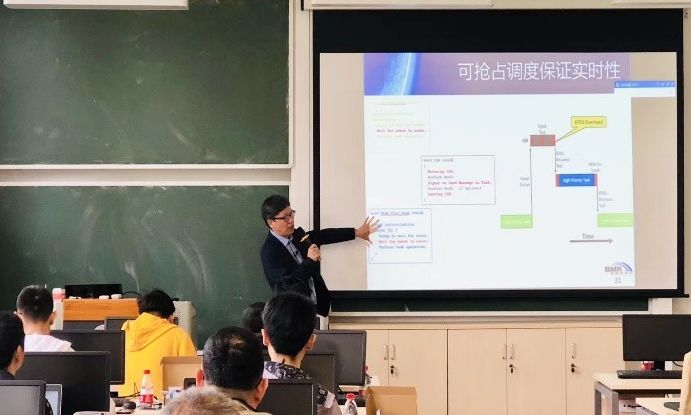
A few days ago, I saw a message from Jean Labrosse on LinkedIn. He informed his friends that he retired on February 28 and will continue to engage in activities related to embedded software, such as giving talks and writing articles. He also mentioned that Silicon Labs has announced the open-sourcing of the Micrium µC/OS series products. Jean is the author of the µC/OS kernel and founded Micrium 20 years ago, focusing on the development and service of µC/OS commercial software. In 2016, Silicon Labs acquired Micrium.
I found the µC/OS that was open-sourced a week ago on GitHub (https://github.com/SiliconLabs). Upon a brief review, I noted that aside from uC/CAN, uC/MPU, uC/timespace, and uC/GUI, both µC/OS-II and µC/OS-III along with their components are fully open-sourced and are all the latest versions. The components originally created for µC/OS are quite rich. uC/MPU and uC/timespace come from the German Embedded office, a company specializing in secure operating systems and certification services, which developed a pre-certified secure operating system based on µC/OS-II. uC/GUI is from Segger’s emWin, a well-known embedded software tools company. The CanOpen open-source protocol can refer to the Embedded office’s open-source code https://github.com/embedded-office.
Micrium’s µC/Probe is a Windows application (see Figure 1) that reads and writes the memory of the embedded target processor at runtime, mapping these values to a set of virtual controls and indicators placed on a graphical dashboard. Using µC/Probe does not require programming; you simply drag and drop the graphical components into place and observe them in action. Every time I conduct training sessions, I find that students really enjoy this software. It is now free, and you can download it from the Dropbox of micrium.com. Friends in China can download it from the technology resources section of bmrtech.com.

Figure 1: µC / Probe Software
In the open-source code directory, I found License.txt, which clearly states that µC/OS is under the Apache License version 2.0. Since it has been open-sourced, Silicon Labs has made a disclaimer and pointed out that “contributors” must provide written electronic notification to [email protected].
What is Weston Embedded? According to their website, it is a company founded by former Micrium engineers, currently focused on two things: µC/OS Support and Consulting Services. It is reassuring to note that Jean mentioned on LinkedIn: “I will most likely help the Weston Embedded guys with anything related to µC/OS-II and µC/OS-III as needed (new features, improvements, etc.).” This means that the µC/OS software will continue to see improvements and new features. From my previous conversations with Jean, the µC/OS-III ARMv7M MPU will be released soon.
At this point, the development trajectory of µC/OS after open-sourcing becomes clear. Many friends might ask: why should we pay special attention to µC/OS when there are already open-source embedded real-time operating systems (RTOS) like FreeRTOS and RT-thread?
In 2017, I published “The Evolution of Embedded Operating Systems: Historical Progress and the Future of IoT,” which includes a chapter titled “The Story of µC/OS.” In brief, an embedded system engineer wrote an open-source RTOS named µC/OS, which gained popularity among global embedded developers through several books. Seeing increasing demand, he founded his own company and continuously developed and maintained this RTOS, transforming an unknown software into an RTOS that stands shoulder to shoulder with world-renowned embedded OS over the span of 20 years (see Figure 2).

Figure 2: 2019 Embedded Market Study (from EETime)
In 2003, Beihang University Press published the translated version of “Embedded Real-Time Operating System µC/OS-II (2nd Edition)” by Professor Shao Beibei of Tsinghua University. This book was very popular and served as the best textbook for embedded developers learning RTOS that year, with 40,000 copies issued. It was through Professor Shao that I got to know Jean. Seven years later, I participated in the translation and publication of the Chinese version of the µC/OS-III series books, along with the development board and training courses (see Figures 3 and 4). The µC/OS-III books also sold over 20,000 copies, and the online courses can be found on NetEase Cloud Classroom https://study.163.com/course/introduction/1004839020.htm.

Figure 3: Series of Chinese Books by the Author of µC/OS

Figure 4: The Author Teaching Based on µC/OS RTOS
According to my estimates, the number of universities in China that have published books, papers, and embedded courses related to µC/OS, covering µC/OS content, should be in the triple digits or even more. After more than a decade of industrial cultivation, µC/OS has seen extensive and mature commercial applications in China, including high-reliability and safety-critical systems, making a significant impact.
In 2016, Micrium was acquired by Silicon Labs. Due to competitive concerns, well-known embedded chip companies like ST and NXP began to support FreeRTOS, and some companies (like TI) started developing their own RTOS. The FreeRTOS integrated into STM32Cube software introduced many Chinese developers to FreeRTOS, and many IoT chip companies preferred to support open-source licensing models, such as Espressif’s WiFi ESP32 using FreeRTOS. The RT-Thread created by Xiong Puxiang established a solid ecosystem in the IoT market and has rapidly developed since receiving funding in 2017, ushering in the 2.0 era of embedded operating systems in China.
What will happen to µC/OS after being open-sourced? It is too early to make a judgment. For embedded operating systems, my viewpoint has always been that it takes a long time for users to recognize and accept a product, and similarly, it is not something that happens overnight for users to abandon a product. Whether an embedded operating system can endure for the long term relies equally on ecological construction and technological innovation.
I would prefer to see a scenario where embedded OSs like FreeRTOS, RT-Thread, Zephyr, and Huawei LiteOS can thrive alongside µC/OS in resource-constrained embedded systems. Of course, this also requires the community, industry, and universities to participate in the maintenance and development of µC/OS, allowing this historically significant embedded software to continue to shine!

A well-known expert in embedded systems, He Xiaoqing has long been engaged in embedded and IoT technology, industry, and education. He has published several Chinese and English works, including “The Evolution of Embedded Operating Systems” and “Embedded Real-Time Operating System μC/OS-III Application Development,” and has published over 80 papers in scientific journals. He frequently speaks at domestic and international embedded systems conferences and teaches at universities and enterprises. Personal website: www.hexiaoqing.net (contains articles, PPTs, and course materials).

1.Code framework BabyOS suitable for MCU projects, a great assistant for engineers!
2.Learn STM32 starting from lighting up!
3.Gather confidence, bear heavy responsibilities! The 2020 Munich Shanghai Electronics Show will debut in July at the National Exhibition and Convention Center (Shanghai).
4. Set up the RT-Thread development environment with Raspberry Pi 3b, give it a try!
5.The top ten working principles for STM32 MPU developers.
6. Behind the investigation results of the Tesla self-driving car accident, is the Autopilot system being overhyped?
